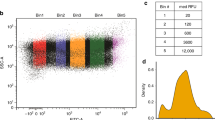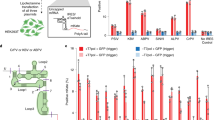Abstract
Eukaryotic translation can be initiated either by a cap-dependent mechanism or by internal ribosome entry, a process by which ribosomes are directly recruited to structured regions of mRNA upstream of the initiation codon. We analysed the 5′ untranslated region (UTR) of the proto-oncogene N-myc, and demonstrated by transfections in a dicistronic vector system that it contains a potent internal ribosome entry segment (IRES). The IRES is similar in length to the c-myc IRES and the activities of these IRESs are comparable in non-neuronal cells. Transfections were also carried out in cell lines derived from neuroblastomas, in which N-myc is expressed, and in a neuronal precursor cell line. In these cells the N-myc IRES is up to seven times more active than that of c-myc, suggesting that neuronal-specific non-canonical trans-acting factors are used by the N-myc but not the c-myc IRES. N-myc expression is increased by gene amplification in many neuroblastomas, but this is the first example of a translational mechanism by which N-myc expression could be further increased. The discovery of an IRES that displays enhanced activity in neuronal cell lines has important potential as a tool for protein expression in neural tissue.
This is a preview of subscription content, access via your institution
Access options
Subscribe to this journal
Receive 50 print issues and online access
$259.00 per year
only $5.18 per issue
Buy this article
- Purchase on Springer Link
- Instant access to full article PDF
Prices may be subject to local taxes which are calculated during checkout





Similar content being viewed by others
References
Akiri G, Nahari D, Finkelstein Y, Le SY, Elroy-Stein O, Levi BZ . 1998 Oncogene 17: 227–236
Bernstein J, Sella O, Le S, Elroy-Stein O . 1997 J. Biol. Chem. 272: 9356–9362
Blackwood EM, Eisenman RN . 1991 Science 251: 1211–1217
Brodeur GM, Segar RC, Schwab M, Varmus HE, Bishop JM . 1984 Science 224: 1121–1124
Chagnovich D, Cohn SL . 1996 J. Biol. Chem. 271: 33580–33586
Coldwell MJ, Mitchell SA, Stoneley M, MacFarlane M, Willis AE . 2000 Oncogene 19: 899–905
Cornelis S, Bruynooghe Y, Denecker G, Van Huffel S, Tinton S, Beyaert R . 2000 Mol. Cell 5: 597–605
Créancier L, Morello D, Mercier P, Prats A-C . 2000 J. Cell Biol. 150: 275–281
Dang CV . 1999 Mol. Cell. Biol. 19: 1–11
Derrington EA, Lopez-Lastra M, Chapel-Fernandez S, Cosset FL, Belin MF, Rudkin BB, Darlix JL . 1999 Hum. Gene Ther. 10: 1129–1138
Henis-Korenblit S, Levy Strumpf N, Goldstaub D, Kimchi A . 2000 Mol. Cell Biol. 20: 496–506
Holcik M, Lefebvre C, Yeh C, Chow T, Korneluk RG . 1999 Nat. Cell Biol. 1: 190–192
Huez I, Creancier L, Audigier S, Gensac MC, Prats AC, Prats H . 1998 Mol. Cell Biol. 18: 6178–6190
Ibson JM, Rabbitts PH . 1988 Oncogene 2: 399–402
Jackson RJ, Hunt SL, Reynolds JE, Kaminski A . 1995 Curr. Top. Microbiol. Immunol. 203: 1–29
Katoh K, Sawai S, Ueno K, Kondoh H . 1988 Nuc. Acids Res. 16: 3589
Kohl NE, Legouy E, DePinho RA, Nisen PD, Smith RK, Gee CE, Alt FW . 1986 Nature 319: 73–77
Lutz W, Stohr M, Schurmann J, Wenzel A, Lohr A, Schwab M . 1996 Oncogene 13: 803–812
Lutz W, Fulda S, Jeremias I, Debatin KM, Schwab M . 1998 Oncogene 17: 339–346
Malynn BA, de Alboran IM, O'Hagan RC, Bronson R, Davidson L, DePinho RA, Alt FW . 2000 Genes Dev. 14: 1390–1399
Miller D, Dibbens J, Damert A, Risau W, Vadas M, Goodall G . 1998 FEBS Lett. 434: 417–420
Nanbru C, Lafon I, Audigier S, Gensac MC, Vagner S, Guez G, Prats AC . 1997 J. Biol. Chem. 272: 32061–32066
Nesbit CE, Tersak JM, Prochownik EV . 1999 Oncogene 18: 3004–3016
Pilipenko EV, Pestova TV, Kolupaeva VG, Khitrina EV, Poperechnaya AN, Agol VI, Hellen CUT . 2000 Genes Dev. 14: 2028–2045
Pozner A, Goldenberg D, Negreanu V, Le SY, Elroy-Stein O, Levanon D, Groner Y . 2000 Mol. Cell Biol. 20: 2297–2307
Pyronnet S, Pradayrol L, Sonenberg N . 2000 Mol. Cell 5: 607–616
Saito H, Hayday AC, Wiman K, Hayward WS, Tonegawa S . 1983 Proc. Natl. Acad. Sci. USA 80: 7476–7460
Schwab M, Alitalo K, Klempnauer KH, Varmus HE, Bishop JM, Gilbert F, Brodeur G, Goldstein M, Trent J . 1983 Nature 305: 245–248
Shea TB . 1994 Neuroreport 5: 797–800
Sivak LE, Pont-Kingdon G, Le K, Mayr G, Tai KF, Stevens BT, Carroll WL . 1999 Mol. Cell Biol. 19: 155–163
Stanton BR, Perkins AS, Tessarollo L, Sassoon DA, Parada LF . 1992 Genes Dev. 6: 2235–2247
Stein L, Itin A, Einat P, Skaliter R, Grossman Z, Keshet E . 1998 Mol. Cell Biol. 18: 3112–3119
Stoneley M, Paulin FEM, Le Quesne JPC, Chappell SA, Willis AE . 1998 Oncogene 16: 423–428
Stoneley M, Chappell SA, Jopling CL, Dickens M, MacFarlane M, Willis AE . 2000a Mol. Cell Biol. 20: 1162–1169
Stoneley M, Subkhankulova T, Le Quesne JPC, Coldwell MJ, Jopling CL, Belsham GJ, Willis AE . 2000b Nuc. Acids Res. 28: 687–694
Strickland S, Mahdavi V . 1978 Cell 15: 393–403
Sugiyama A, Miyagi Y, Shirasawa Y, Kuchino Y . 1991 Oncogene 6: 2027–2032
Thiele CJ, Reynolds CP, Israel MA . 1985 Nature 313: 404–406
Vagner S, Gensac MC, Maret A, Bayard F, Amalric F, Prats H and Prats AC . 1995 Mol. Cell. Biol. 15: 35–44
Zimmerman KA, Yancopoulos GD, Collum RG, Smith RK, Kohl NE, Denis KA, Nau MM, Witte ON, Toran-Allerand D, Gee CE, Minna JD, Alt FW . 1986 Nature 319: 780–783
Acknowledgements
This work was funded by the BBSRC (advanced fellowship to AE Willis). CL Jopling holds an MRC studentship.
Author information
Authors and Affiliations
Rights and permissions
About this article
Cite this article
Jopling, C., Willis, A. N-myc translation is initiated via an internal ribosome entry segment that displays enhanced activity in neuronal cells. Oncogene 20, 2664–2670 (2001). https://doi.org/10.1038/sj.onc.1204404
Received:
Revised:
Accepted:
Issue Date:
DOI: https://doi.org/10.1038/sj.onc.1204404
Keywords
This article is cited by
-
A previously unknown Argonaute 2 variant positively modulates the viability of melanoma cells
Cellular and Molecular Life Sciences (2022)
-
Remodelling of a polypyrimidine tract-binding protein complex during apoptosis activates cellular IRESs
Cell Death & Differentiation (2014)
-
Translational control in cancer
Nature Reviews Cancer (2010)
-
Upstream ORF affects MYCN translation depending on exon 1b alternative splicing
BMC Cancer (2009)
-
MYCN haploinsufficiency is associated with reduced brain size and intestinal atresias in Feingold syndrome
Nature Genetics (2005)



